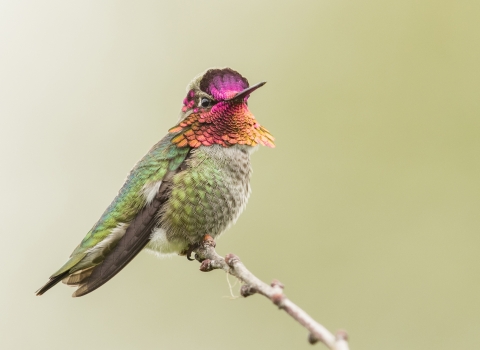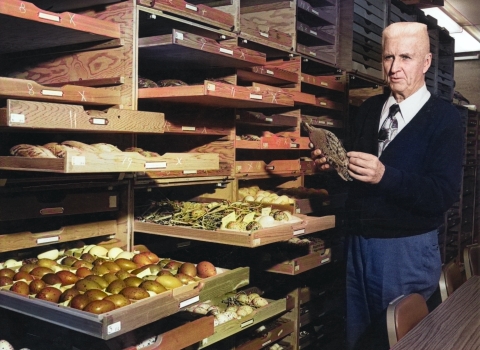Ron Regan, Vermont Fish and Wildlife Dept., 802-241-3700
Larry Nashett, New York State DEC, 518-897-1333
Renewed Sea Lamprey Control Program Proposed to Revive Native Fisheries in Lake Champlain
A proposal for a comprehensive program to control the devastating environmental impacts of sea lamprey in Lake Champlain was announced today by Lake Champlains Fish and Wildlife Management Cooperative, including the Interior Departments U.S. Fish and Wildlife Service, the Vermont Fish and Wildlife Department, and the New York State Department of Environmental Conservation."Weve reached a turning point in our efforts to restore trout and salmon in one of the most valuable watersheds in the Northeast," said Dr. Mamie A. Parker, the Services acting Northeast regional director.
"Sharing expertise with states and conservation partners over the last several years has really helped us refine a balanced call to action for controlling sea lamprey and keeping fish and wildlife healthy in Lake Champlain," Parker added. "Weve also benefitted greatly from listening to the perspectives of people in neighboring communities about the importance of Lake Champlain to their way of life."
"This release of the Draft Supplemental Environmental Impact Statement is an important milestone on the path of improving Lake Champlain salmonid fisheries," said Vermont Fish and Wildlife Commissioner Ronald Regan. "This document is the result of great interagency staff work and we look forward to discussing the recommendations with all interested parties."
The sea lamprey is a parasitic invasive species invasive species
An invasive species is any plant or animal that has spread or been introduced into a new area where they are, or could, cause harm to the environment, economy, or human, animal, or plant health. Their unwelcome presence can destroy ecosystems and cost millions of dollars.
Learn more about invasive species known for decimating fisheries throughout the Great Lakes region, and has been the object of one of the largest international fisheries management programs for nearly 50 years.
Native to the northern Atlantic Ocean, sea lamprey are believed to have invaded Lake Champlain in the 1800s, and reached the Great Lakes in the 1930s after canals allowed the lamprey to bypass natural barriers to their inland migration. The eel-like vertebrates aggressive, predatory behavior allows it to take advantage of native fish prey, including Atlantic salmon, lake trout, and walleye.
The notice of availability of a Draft Supplemental Environmental Impact Statement, to be published soon in the Federal Register for a 45-day public comment period, recommends strategies for a long-term, integrated sea lamprey control program for Lake Champlain.
According to David Tilton, leader for the Fish and Wildlife Services Lake Champlain operations, the program would step up efforts to use advanced technology to:
*Precisely apply chemical lampricides to control sea lamprey larvae in certain streams and delta areas before they transform into parasitic adults,
*Prevent adult sea lamprey movement into some stream spawning areas either by trapping or construction of barriers, and
*Continue investing in research on sea lamprey life cycles, distribution, and abundance among several agencies and organizations to continually refine these activities.
Tilton explained that the supplemental EIS builds on an 8-year experimental sea lamprey control program for Lake Champlain, which ended in 1997. The Lake Champlain Fish and Wildlife Management Cooperative undertook extensive evaluation studies to measure the success of the program.
Evaluation deemed the experimental program successful in creating a notable comeback for several native sport fisheries, according to Tilton. Non-target losses have been minimal, and have not jeopardized the long-term health and sustainability of affected aquatic species populations. Success is attributed to precisely controlled application of the lampricide TFM to 13 stream systems and Bayluscide granules to five delta areas to target sea lamprey during their larval stage.
These chemicals have been the primary tool for sea lamprey control throughout the Great Lakes region over the last 40 years, Tilton said.
More recently, a series of public scoping meetings on developing a long-term program were held in Vermont and New York.
Todays proposal introduces a new screening process for selection of lampricides or other feasible alternative control methods on a tributary-by-tributary basis, Tilton explained. Initially targeting 20 Lake Champlain stream systems for possible control activities, this process will lead to more integration of available control methods, he added.
The draft supplemental EIS presents three possible approaches to sea lamprey control in Lake Champlain:
*A long-term, integrated control program using trapping, barrier construction, and selective use of lampricides,
*Continuing control using only chemical treatments similar to the experimental program, or
*Taking no action.
The first approach is the route now recommended by the Lake Champlain Fish and Wildlife Management Cooperative. The cooperative expects to have a final decision on the program by August 2001, Tilton said.
An Environmental Impact Statement is a thorough analysis of a federal agencys planned actions that could significantly affect the environment. Open to public input, these documents are required under the National Environmental Policy Act.
The public is invited to comment on the proposed sea lamprey program during the 45-day comment period, through April 30, 2001. It is available at many public libraries and state field offices, and the Fish and Wildlife Service's Lake Champlain office; the latter can direct people to the nearest location. Comments should be addressed to Mr. David Tilton, Project Leader, USFWS Lake Champlain Office, 11 Lincoln Street, Essex Junction, Vermont, 05452; telephone 802-872-0629, fax 802-872-9704; or may be submitted electronically to dave_tilton@fws.gov">.
The Lake Champlain Fish and Wildlife Management Cooperative will host public hearings on the proposal on March 28 from 7 p.m. to 9 p.m. at Willsboro Central School in Willsboro, New York, and on April 4 from 7 p.m. to 9 p.m. at South Burlington High School in South Burlington, Vermont.
The U.S. Fish and Wildlife Service is the principal Federal agency responsible for conserving, protecting and enhancing fish, wildlife and plants and their habitats for the continuing benefit of the American people. The Service manages the 93-million-acre National Wildlife Refuge System which encompasses more than 530 national wildlife refuges, thousands of small wetlands and other special management areas. It also operates 66 national fish hatcheries, 64 fishery resource offices and 78 ecological services field stations. The agency enforces Federal wildlife laws, administers the Endangered Species Act, manages migratory bird populations, restores nationally significant fisheries, conserves and restores wildlife habitat such as wetlands, and helps foreign governments with their conservation efforts. It also oversees the Federal Aid program that distributes hundreds of millions of dollars in excise taxes on fishing and hunting equipment to state fish and wildlife agencies.
FWS


